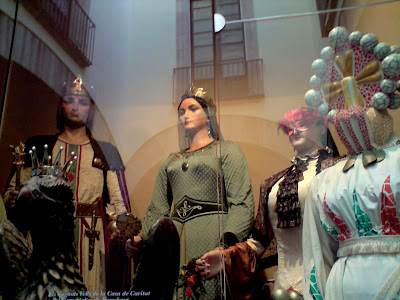Loads of you will have passed by Barcelona council's Institue of Culture building on Las Ramblas, and probably not even realised. It's located on Las Ramblas, number 99, and is set slightly back from its neighbouring buildings. They always have a gallery exposition announced on the balconies. Know which one I mean? Well, the building is an old Palace, Palau de la Virreina, and although it's not very well publicised you can enter for free into the courtyard and see some of the most famous characters Barcelona has....els gegants.

The Barcelona giants are ceremonial mannequins used in the corpus Christi parade, amongst others. According to the history displays, which are completely free to visit, but not well publicised, the giants were commissioned in 1859 by the “Societat del Born” to take part in the Carnival celebrations, held each year in February and of which the nearby seaside town of Sitges has become renowned.

The Giants comprise of a male and female figure, rather like a King and Queen, a little girl, an eagle, two masked younger figures and a headless tribute to Gaudi – the famous Catalan artist responsible for 7 of Barcelona’s 9 UNESCO World Heritage sites.
Quoting directly from the information within the Institute of Culture, “In 1891 the giants were transferred to the Casa de Caritat, a dependency of the Deputation of Barcelona. They were used for the entertainment of orphans, formed a special feature in the Corpus Christi processions of this charitable institution and also took part in many festivals. They were restored in 1986 by Domenec Umbert. The Old Carnival Giants of the Casa de Caritat face the 21st century as the most symbolic figures in the celebrations of Carnival and Corpus Christi in Barcelona.” The giants are also paraded with pride during the week of the 24th September, when the “La Merce” festivals commence – the patron saint of Barcelona is Our Lady of Mercy.
Perhaps a puzzling figure within the giants is the crowned golden Eagle. Again, quoting from the official information, “The Barcelona Eagle is mentioned in documents as far back as 1399. As it was part of the municipal cortège, it was subject to strict protocol and was indispensable at all solemn city celebrations and on the aldermen’s journeys.
The Eagle lived its golden age in the 17th century when it was the subject of a number of dances and tunes. It disappeared in the first third of the last century and was recovered in 1989. The Eagle is part of the historic bestiary of Barcelona, together with the Lion, the Big Mule, the Bull, the Viper, the Dragon, the Monster and the little horses”.
Also of note is the “little giant – or gegantona” – who represents the figure of a girl from the 4th Century, when Saint Eulalia, one of Barcelona’s co-patron saints after the aforementioned Our Lady of Mercy, is said to have lived. Santa Eulalia was a young girl who suffered torture and ultimately crucifixion from the then Governor of Barcelona, Dacian, for her criticism of his treatment against the Christians. The figure of “Laia”, as she was more affectionately known, “represents the brave, caring spirit of the citizens of Barcelona. The giantess first appeared in 1998 for the celebration of Santa Eulalia’s day and is the newest member of the great family of figures which appear in the Barcelona festivals”.

It appears that the tradition caught on, and there are other neighbourhoods in the city who have their own giants, which are used in each neighbourhood party/festival. For example, my son's school in the neighbourhood of Sant Antoni, has 2 giants and 2 "little giants" in the entrance to the school that were used at the end of January.

Coming to Barcelona soon? Try a self-catering apartment in Barcelona as a great alrternative to a hotel room. Or if you're in a group, look at apartments for groups in Barcelona.
Like what you're reading? Please leave me a comment if you're interested, or would like me to blog about anything in particular.











0 comments:
Post a Comment